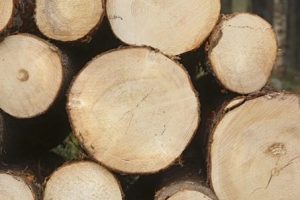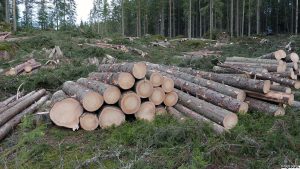On the 15th of June, Sveaskog informed that they will decrease their annual felling by 1 million cubic meters. That is 1,25 percent of Sweden’s, and 20 percent of Sveaskog’s total annual felling.
Sveaskog cuts down on cutting
The Swedish state forest Sveaskog is by far Sweden’s largest forest owner with 3,9 million hectares of forest land. The state-owned company has a reputation for felling hard in their forests. Many claim it’s been a conscious strategy to help the industry keep the wood prices down, and a contribution to that Sweden has Europe’s cheapest timber.
One million cubic meters or 1,25 percent of the annual felling may not seem so much. But considering the current situation where Sweden already fells the annual growth (some claim even more) and the industry is running at full gas and cries for raw material, this could have an effect in the long run. So, in a situation where the felling limit is reached, the largest forest owner decides to fall less.
Could it be financially sound for Sveaskog?
The colleague Fredrik at the sister site iSkogen.se had a chat with the new CEO of Sveaskog Erik Brandsma. Brandsma confirmed that an economical calculation was made before the decision to cut down on felling. The new strategy will affect Sveaskog’s financial results negative, in a short term.
Photo: Sveaskog
What will happen in the long run is another question. We have a forest industry, both in Sweden and the rest of Europe, that for the moment have problems getting raw material after all the bark-beetle felling. In addition to that, the purchase of timber and lumber from Russia and Belarus has stopped.
The result could be that the timber prices in Sweden are rising and that Sveaskog’s profit becomes higher, or at least stays on the same level as before. And Sveaskog’s timber stock will grow as they will fell less which also means better finances in the long run.
A part of the “new Sveaskog”
During the chat, Erik Brandsma mentions “the new Sveaskog”. Is the new strategy, with less felling, a part of this “new” state forest company? To be quite honest, Sveaskog has probably no options but to decrease their felling as they, until now, have been felling very hard. So hard that they have been criticized for that. But Sveaskog points out that the decrease in felling levels could be temporary.
According to Brandsma, Sveaskog will focus on the production of sawlogs. He doesn’t say if this is a part of the new strategy, but it seems so to us. As for the possibility to sell carbon storage, Brandsma says that they are looking into that. Considering that their stock of standing forests will grow, that should be an option worth looking at. Brandsma points out that avoiding staff reductions is one of the most important issues that Sveaskog is looking at right now.
Photo: Fredrik Reuter
What do the owners say?
The owners, the Swedish state, are normally very keen on keeping the forest industry going. The present Swedish government struggle against new EU directives that will mean lower felling levels in the Swedish forests. One can guess that the government is not undividedly positive about Sveaskog’s decision.
But the owners, the state, means all of us, Swedish citizens who include the forest owners. For them, this could be good as the timber prices finally should rise. If this happens, it will be a very good step in the right direction. Also, the forest contractors should gain from this in the long run.
As for our politicians, they might have to think again. Maybe they could be inspired by the new Sveaskog strategy? Bear in mind that in September a new parliament and government (?) will be elected in Sweden.
This is a summary of an article at iSkogen.se signed Fredrik Reuter.















